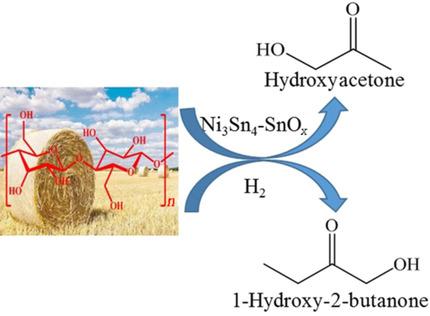当前位置:
X-MOL 学术
›
ChemSusChem
›
论文详情
Our official English website, www.x-mol.net, welcomes your
feedback! (Note: you will need to create a separate account there.)
Selective Conversion of Cellulose to Hydroxyacetone and 1‐Hydroxy‐2‐Butanone with Sn–Ni Bimetallic Catalysts
ChemSusChem ( IF 7.5 ) Pub Date : 2019-03-12 , DOI: 10.1002/cssc.201900172 Haiyong Wang 1, 2, 3, 4 , Changhui Zhu 1, 2, 3, 4 , Qiying Liu 1, 2, 3, 5 , Jin Tan 1, 2, 3 , Chenguang Wang 1, 2, 3 , Zheng Liang 1, 2, 3 , Longlong Ma 1, 2, 3
ChemSusChem ( IF 7.5 ) Pub Date : 2019-03-12 , DOI: 10.1002/cssc.201900172 Haiyong Wang 1, 2, 3, 4 , Changhui Zhu 1, 2, 3, 4 , Qiying Liu 1, 2, 3, 5 , Jin Tan 1, 2, 3 , Chenguang Wang 1, 2, 3 , Zheng Liang 1, 2, 3 , Longlong Ma 1, 2, 3
Affiliation

|
The high‐value‐added chemicals hydroxyacetone (HA) and 1‐hydroxy‐2‐butanone (HB) were produced from agricultural waste over a Ni3Sn4‐SnOx catalyst. The Sn–Ni intermetallic compound and SnOx acted as the active sites for HA and HB production by selectively cleaving the target C−C and C−O bonds. Approximately 70 % of the total HA and HB yield was obtained by selective hydrogenolysis of cellulose. This strategy expands the application of cellulose towards renewable production of high‐value C3 and C4 keto‐alcohols from cellulosic biomass.
中文翻译:

Sn-Ni双金属催化剂将纤维素选择性转化为羟丙酮和1-羟基-2-丁酮
高附加值的化学品羟基丙酮(HA)和1-羟基-2-丁酮(HB)是通过农业废料在Ni 3 Sn 4 -SnO x催化剂上生产的。所述的Sn-Ni金属间化合物和SnO X充当通过选择性地切割靶C-C和C-O键的活性位点的HA和HB的生产。通过纤维素的选择性氢解,获得了总HA和HB总产率的约70%。该策略将纤维素的应用范围扩展到了由纤维素生物质可再生生产高价值的C 3和C 4酮醇的过程。
更新日期:2019-03-12
中文翻译:

Sn-Ni双金属催化剂将纤维素选择性转化为羟丙酮和1-羟基-2-丁酮
高附加值的化学品羟基丙酮(HA)和1-羟基-2-丁酮(HB)是通过农业废料在Ni 3 Sn 4 -SnO x催化剂上生产的。所述的Sn-Ni金属间化合物和SnO X充当通过选择性地切割靶C-C和C-O键的活性位点的HA和HB的生产。通过纤维素的选择性氢解,获得了总HA和HB总产率的约70%。该策略将纤维素的应用范围扩展到了由纤维素生物质可再生生产高价值的C 3和C 4酮醇的过程。

















































 京公网安备 11010802027423号
京公网安备 11010802027423号